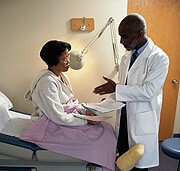
MONDAY, June 20 (HealthDay News) — A female contraceptive device whose reported side effects kept it off the frontline of birth control for years has been formally endorsed for all healthy adult women and adolescents by the American College of Obstetricians and Gynecologists.
The endorsement represents a new chapter in the history of intrauterine devices (IUDs). The T-shaped pieces of plastic laced with copper or hormones to prevent pregnancy may raise the risk of pelvic inflammatory disease, which can result in serious complications, including infertility, according to the Mayo Clinic.
But many experts say that risk is small, and the new recommendations, published in a Practice Bulletin in the July issue of Obstetrics & Gynecology, replace guidelines issued in January 2005.
At that time, only women who had given birth and were at low risk for sexually transmitted diseases were considered routine candidates for IUDs. However, researchers say other women and adolescents have been using them, despite the lack of official endorsement from the organization until now.
IUDs, once unpopular in the United States, are “safe” and “cost-effective,” said Dr. Adam Jacobs, medical director of the family planning division at Mount Sinai Medical Center in New York City.
“What you see now is a rethinking of the idea of how to prevent unintended pregnancy,” said Jacobs, calling IUDs the “most cost-effective form” of birth control available.
Jacobs, also an assistant professor of obstetrics and gynecology, said the new guidelines reflect what has been the practice at bigger teaching hospitals for some time. At Mount Sinai, adolescents and adult women have received IUDs for three years, he said.
Another expert agreed that IUDs have been in common use for several years.
“It’s really not new,” said Dr. Jill Rabin, chief of the ambulatory care division and head of urogynecology at North Shore Long Island Jewish Medical Center in New Hyde Park, N.Y. She noted that a lack of knowledge and access explain the relatively lower use rates for IUDs and implants, and urged doctors to spread the word.
“It is incumbent upon practitioners to help inform and educate our patients about the many benefits, as well as safety, of these methods for the majority of women,” said Rabin.
About 6 percent of women using birth control choose IUDs or hormonal implants, another long-acting contraceptive, according to the bulletin. But rates are quickly rising as women learn more about them, according to both Jacobs and Rabin.
“Encouraging the use of long-acting reversible contraceptive methods for appropriate candidates may help lower U.S. unintended pregnancy rates because gaps in use and discontinuation of shorter acting methods are associated with unintended pregnancy rates in high-risk women,” according to the Practice Bulletin. No such gaps in use occur with long-acting devices.
IUDs are inserted into the uterus and are available in two types: either a small T-shaped instrument with copper wire threaded around the T, or a T-shaped device with a hormone emission system.
Few birth control methods are risk-free, however, and IUDs are more likely to increase the risk of pelvic inflammatory disease if women have more than one sexual partner, according to the American Pregnancy Association.
IUDs can cause other side effects. These include headache, weight gain, ovarian cysts, mood changes, and pain or irregular bleeding (hormonal IUD) and anemia, heavy bleeding, backache, severe menstrual pain, painful sex and inflammation of the vagina and rash (copper IUD), according to the Mayo Clinic. The side effects often lessen or go away over time, according to the research the guidelines are based on.
In general, IUDs can safely stay in place for up to 10 years, according to the U.S. Food and Drug Administration.
Hormonal implants, matchstick-sized rods that are placed under the skin surface, emit a progestin type hormone for three years. The implants are “the most effective method of reversible contraception,” with a failure rate for typical users of 0.05 percent, according to information in the Practice Bulletin. IUDs have a failure rate of less than 1 percent.
IUDs and hormonal implants cost between $400 and $750, not including the doctor’s fee, with at least part of the expense covered by most insurance plans, said Jacobs.
In the 1970s, the Dalkon shield, a brand of IUD with a unique design, was taken off the market after being linked to pelvic inflammatory disease and infertility caused by sexually transmitted disease in women using the device, said Jacobs.
Some types of copper IUDs were later linked to pelvic inflammatory disease as well, although some experts say the risk has been overestimated.
There was no similar concern about implants, which have been in use for many years, he said.
“From both a patient standpoint and a social standpoint,” IUDs and implants are beneficial because they “keep young women in school” instead of falling into a life of poverty that can follow unintended pregnancies and a lack of education, said Jacobs.
More information
To learn more about the guidelines, visit the American Congress of Obstetricians and Gynecologists.

